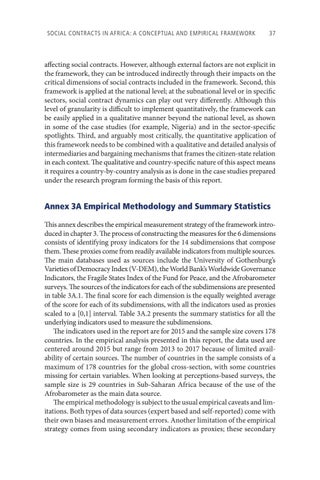Social Contracts in Africa: A Conceptual and Empirical Framework 37
affecting social contracts. However, although external factors are not explicit in the framework, they can be introduced indirectly through their impacts on the critical dimensions of social contracts included in the framework. Second, this framework is applied at the national level; at the subnational level or in specific sectors, social contract dynamics can play out very differently. Although this level of granularity is difficult to implement quantitatively, the framework can be easily applied in a qualitative manner beyond the national level, as shown in some of the case studies (for example, Nigeria) and in the sector-specific spotlights. Third, and arguably most critically, the quantitative application of this framework needs to be combined with a qualitative and detailed analysis of intermediaries and bargaining mechanisms that frames the citizen-state relation in each context. The qualitative and country-specific nature of this aspect means it requires a country-by-country analysis as is done in the case studies prepared under the research program forming the basis of this report.
Annex 3A Empirical Methodology and Summary Statistics This annex describes the empirical measurement strategy of the framework introduced in chapter 3. The process of constructing the measures for the 6 dimensions consists of identifying proxy indicators for the 14 subdimensions that compose them. These proxies come from readily available indicators from multiple sources. The main databases used as sources include the University of Gothenburg’s Varieties of Democracy Index (V-DEM), the World Bank’s Worldwide Governance Indicators, the Fragile States Index of the Fund for Peace, and the Afrobarometer surveys. The sources of the indicators for each of the subdimensions are presented in table 3A.1. The final score for each dimension is the equally weighted average of the score for each of its subdimensions, with all the indicators used as proxies scaled to a [0,1] interval. Table 3A.2 presents the summary statistics for all the underlying indicators used to measure the subdimensions. The indicators used in the report are for 2015 and the sample size covers 178 countries. In the empirical analysis presented in this report, the data used are centered around 2015 but range from 2013 to 2017 because of limited availability of certain sources. The number of countries in the sample consists of a maximum of 178 countries for the global cross-section, with some countries missing for certain variables. When looking at perceptions-based surveys, the sample size is 29 countries in Sub-Saharan Africa because of the use of the Afrobarometer as the main data source. The empirical methodology is subject to the usual empirical caveats and limitations. Both types of data sources (expert based and self-reported) come with their own biases and measurement errors. Another limitation of the empirical strategy comes from using secondary indicators as proxies; these secondary

